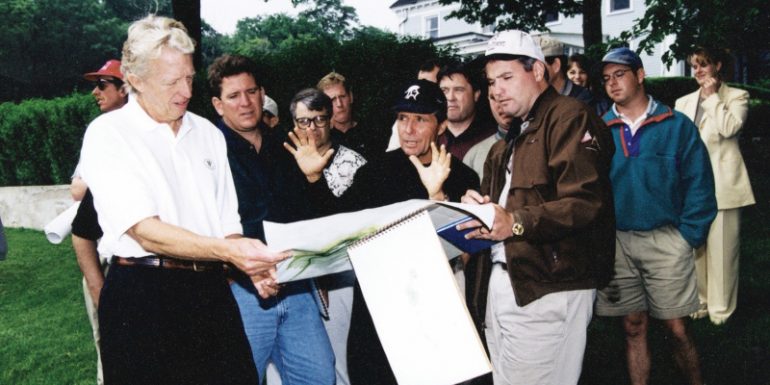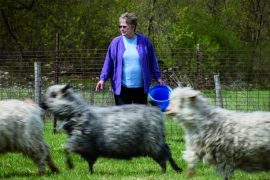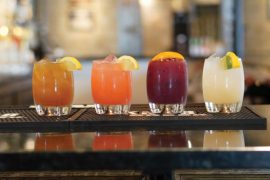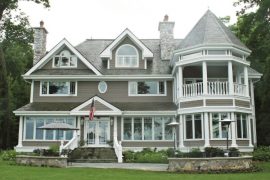By Anne Morrissy | Photo courtesy Geneva National
On the morning of Feb. 7, 1990, former Geneva National Membership Director Katie Alder and a team of four real estate sales professionals for the powerhouse Anvan Company stood in a newly renovated barn-turned-sales-office and prepared for a momentous day. The barn, located off Highway 50 between Geneva Lake and Lake Como, had just taken on a new life as the sales office for a recently announced residential golf community to be called Geneva National. In the middle of the barn stood an elaborate three-dimensional model of the roughly 1,600-acre parcel of land, with plans of the future community drawn to scale. “The display depicted single-family home and multiple-family condominium locations, the [three] signature golf courses, club locations, future [buildable] properties and commercial locations,” Alder remembers. In both size and level of amenity, the area had nothing quite like it.
Geneva National was the brainchild of Anthony “Tony” Antoniou, president of the Anvan Company, and his sons, Andy and Vance. By 1990, the Antonious were familiar leaders in the hospitality industry in Walworth County, owning or managing several iconic resort properties in the area. For this new venture, the Antonious were branching out: Geneva National would include three world-class golf courses designed by golf legends Gary Player, Lee Trevino and Arnold Palmer (all visited Geneva National to play their own signature course); plus a hunt club; restaurant; and a full-amenity, gated residential community with condos, townhomes and single-family homes.
Word of the project spread quickly, and by the time Alder and her team opened the doors to the new sales office that February day, there were many people eager to get a look at the plans. “People were packed in there,” explains Howard Storck, 30-year resident of Geneva National and current chairman of the Architectural Review Committee for the homeowners association. Storck was an early investor and is one of Geneva National’s charter homeowners. “Golf is my passion,” he says. “So even before they opened a sales office, I knew it was something I wanted to be involved in.”
He wasn’t alone. According to Alder, “Weekends during the first five months were a frenzy of activity,” and resulted in sales totaling over $60 million.
TEEING IT UP
Vance Antoniou, current president of Anvan, says that one reason for the project’s popularity was that from its earliest days, Geneva National drew attention from both golfers and non- golfers. “It was a home run in every way,” he remembers. “In the beginning, I worked the sales floor myself every single day. I think I finally stopped at around 100 straight days of working.”
In fact, long before the first day of sales, Antoniou and his team had invested an enormous amount of work just to get the project off the ground. By the late 1980s, Antoniou says that Anvan had identified a need for more top-flight golf courses in the area to entice large groups and conventions to the local resorts. “We came up with our concept, which was that we wanted golf courses that were designed by famous golfers who were seniors — at the time, because our target demographic was golfers in their 40s to their 60s,” Antoniou explains. Several golf luminaries ran their own golf course-design companies to create what are known as “signature courses.” Anvan decided to partner with three of these legends — Arnold Palmer, Lee Trevino and Gary Player — each of whom tasked their architects with creating an 18-hole course for the new development.
Before any golf course design could get under way, however, the architects needed to know what the topography of the site looked like. After making inquiries, Anvan found several farmers in Geneva Township around the west end of Lake Como who were willing to sell their land. The company ended up purchasing about 1,600 acres, more than four times their goal.
According to Antoniou, after buying the land, the first step in the project was to complete extensive environmental, historical and land-use studies. He points out that these studies were used by all the involved parties to design the community in a way that was sensitive to both the history of the property and the potential environmental impact. “We were told [by the DNR] that the lake water quality was going to improve [at the completion of the project.] The land along Lake Como at the time was farmland so the lake was previously full of fertilizers. Because of the work we did was carefully planned and environmentally sensitive, the lake quality got better.”
The Palmer and Trevino courses opened in 1991, with the Player course taking slightly longer to complete, partly to allow for the development of the Hunt Club. According to Alder, Tony Antoniou was an avid hunter and preferred to keep some of the property “wild” to use for that purpose. “Tony’s heart was with the Hunt Club,” she says. “He was very involved with the development of it.”
FROM FAMOUS THOROUGHBREDS TO CORPORATE PHILANTHROPY
The land that would eventually become Geneva National boasted an interesting history. As early as 700 A.D., Late Woodland Indians had inhabited the site, and it was discovered that the land contained more than 40 effigies and remnants of Native American dwellings, all of which were studied and documented by the state of Wisconsin prior to Geneva National’s construction.
In the property’s more recent history, as early as 1907, Chicago banking heir Albert W. Harris began buying land on the western shore of what was then known as Duck Lake to pursue one of his life’s passions: horses. Harris began a horse breeding operation called Kemah Farms on the property, where he developed a nationally revered horse breed once known as the “Harris Arabian.” To take full advantage of the property, Harris also built a Spanish Colonial Revival home on a high elevation overlooking the lake. The Harris family used the home until late in Harris’s life, when a portion of the property was sold to the Chicago Boys Club for one dollar.
In a similarly philanthropic move, in 1928 on 510 acres of adjacent land, Charles R. Crane II and the leaders of Chicago’s Crane Company opened Crane Farms, a sanitarium and summer camp for company employees and their families. The sanitarium could host up to 14 employees, providing a place for rest and relaxation, which was much needed according to Alder, who says that heavy metal poisoning was a common ailment among employees of the era due to the manufacturing processes prevalent at the time.
In addition to the sanitarium, several cabins throughout the property provided lodging for both children and adults, and children were welcomed to Crane Farms for two-week camp sessions throughout the summer, all at the company’s expense. Crane Farms remained operational until 1958, when it, too, was given to the Chicago Boys Club to create what was then the largest Boys Club camp in the country. Today, the original, historic sanitarium building has been thoroughly renovated and serves as the site of Geneva National’s much-lauded Hunt Club Steakhouse.
ON PALOMA’S WINGS
In 1996, the family-owned and operated Paloma Resort Group purchased Geneva National’s golf courses, hunt club and clubhouse, and the community began to operate independently. It was a natural fit for the company, which specialized in the management of golf communities and already owned or managed eight similar properties around the country at the time.
“It was a pretty obvious choice for us,” explains Garth L. Chambers, current president of Paloma Resort Properties. “When you look at a map and you connect the dots, with the potential of having a world-class facility, the outstanding golf, this wonderful community, and you’re just 90 minutes away from 13 million people in the greater Chicagoland area … it was very attractive to us.”
According to Chambers, as soon as Paloma took over, they began enhancing resort amenities. Since 1996, these updates have included: completing the Player golf course; opening a state-of-the-art wellness center; renovating the Hunt Club into an award- winning, nationally recognized steakhouse; redesigning the Inns of Geneva National for short-term stays; and constructing 32 new on-course executive suites in 2020.
The Geneva National homeowners association is separate from Paloma, and it operates autonomously. Rick Pozdol, the association’s executive director, explains some of the tasks he and his staff are responsible for each year: “In a lot of cases, we are doing things that are more like a municipality would do. We produce the water, treat the water, collect sanitation; we own the roadways, water lines and sewer lines, and it’s up to us to fix, replace, and repair anything that needs it. We wear a lot of hats.” Pozdol and his team are also responsible for maintenance and property management of all of the multi-family units, management of the clubhouse, the pool, the tennis courts and the restaurants as well as general event coordination.
Chambers says it’s this full-amenity living that attracts many of Geneva National’s homeowners. “People love the on-campus community living,” he explains. “It’s almost like college for adults. It creates an energy.”
Pozdol adds they’ve just completed one of their busiest real estate years in Geneva National’s history, reflecting a larger national trend related to the COVID-19 pandemic. Chambers explains that a recent census determined that around 50% of homeowners are currently using their Geneva National home as their primary residence, a number that is higher than in past years.
FURTHER DOWN THE FAIRWAY
The increased interest in the Geneva Lakes area has inspired both Chambers, representing the resort, and Pozdol, acting on behalf of the community, to look to future projects. For Chambers, the array of offerings — from golf, lodging, and food and beverage to special events and private memberships are always at the forefront. Last summer’s debut of 32 luxury suites bring a new dimension to the resort’s accommodations and are ideal for golfers wanting a stay and play experience. For Pozdol, possible future community projects for residents may include a dog park, nature and exercise paths, a playground and increased access to and enhancement of Geneva National’s lake frontage.
Chambers points out that 30 years after the Palmer and Trevino courses opened, golf continues to be a major draw to Geneva National. “There’s not too many places that have three signature golf courses in one location,” he explains. “There’s only a handful like that in the country, [and at Geneva National,] the topography is unique. The Palmer course here, for instance, is like a nature walk for four hours. You could spend two or three days playing golf here and never have the same shot or look at a hole.”
As he considers the future, Chambers says that he never loses sight of what has always made Geneva National unique. “I do think the people are what makes Geneva National special,” he says. “This community and our resort really bring people together. Anytime I talk to homeowners or I have friends who visit or we host an event here, the takeaway is: I can’t believe how much fun everybody has here. It’s just the quality of the people Geneva National has attracted over the years.”





